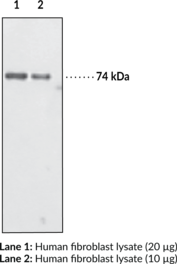Description
The toll-like receptor (TLR) family in mammals comprises a family of transmembrane proteins characterized by multiple copies of leucine rich repeats in the extracellular domain and an interleukin-1 (IL-1) receptor motif in the cytoplasmic domain. Like its counterparts in Drosophila, TLRs signal through adaptor molecules.{17503} Interleukin-1 receptor-associated kinases (IRAKs) are important mediators in the signal transduction of Toll/IL-1 receptor (TIR) family members.{18761} The cytoplasmic domains of TIR proteins interact with the adapter protein, MyD88. MyD88 then recruits IRAKs (IRAK-1-4), which in turn interact with other adapter molecules, such as TRAF6 to activate NF-κB and MAPK pathways. A member of this family, IRAK-4 has been identified.{18762} IRAK-4 may act as an upstream activator of IRAK-1. IRAK-4 is important for LPS activation of TLRs. Mice lacking IRAK4 are resistant to lethal doses of LPS and are also severely impaired in their responses to viral and bacterial challenges.{18763,18764}
Synonyms: Interleukin-1 Receptor-Associated Kinase-Like 4
Immunogen: synthetic peptide corresponding to a mixture of mouse IRAK-4 amino acids 38-54 and 120-136
Formulation: 100 µg protein G-purified IgG in 200 µl PBS containing 0.05% BSA and 0.05% sodium azide
Isotype:
Applications: IP and WB
Origin:
Stability: 180 days
Application|Immunoprecipitation||Application|Western Blot||Product Type|Antibodies|Polyclonal Antibodies||Research Area|Immunology & Inflammation|Innate Immunity|Pattern Recognition||Research Area|Infectious Disease|Bacterial Diseases||Research Area|Infectious Disease|Parasitic Diseases




